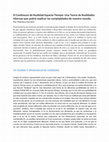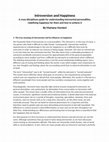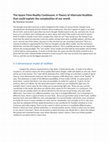Papers by Mariana Vernieri

El pensamiento de universos paralelos a menudo queda relegado al ámbito de la ciencia ficción. A ... more El pensamiento de universos paralelos a menudo queda relegado al ámbito de la ciencia ficción. A pesar de que algunos astrofísicos hayan desarrollado y desarrollen intrincadas teorías sobre los multiversos, éstas no parecen aplicarse a nuestra vida cotidiana en la Tierra, y no les damos demasiada importancia. La realidad parece ser una y sólo una. Así que nos enfocamos en eso, como si no hubiera nada más de qué preocuparse. Pero, ¿y si este mundo no es lo que parece? ¿Qué si la realidad es mucho más compleja de lo que vemos? ¿Cómo cambiaría tu vida si supieras que el mundo que percibes es solo una opción entre muchas otras opciones disponibles, y que la ves, y no a ninguna otra, porque es la que eliges percibir? Existe un volumen de evidencia que respalda el hecho de que nuestros pensamientos realmente afectan la materia, pero el mecanismo detrás de esto y su razón de ser, es completamente desconocido. Esto es probablemente porque estamos viendo todo esto desde un paradigma equivocado. El modelo lineal de que existe una realidad, que es actualmente sostenido por la mayoría de las personas y de los científicos, está lleno de fallas y paradojas. Parece ser así, de la misma manera que la Tierra parecía ser plana y los otros cuerpos celestes parecían girar alrededor de ella. Pero ahora sabemos que las apariencias nos pueden engañar, y éste puede ser el mayor ejemplo de ello. Un modelo 5-dimensional de realidades Imagina al universo representado como un gran cubo negro de 5 dimensiones. Para poder visualizarlo, necesitamos reducir las tres dimensiones espaciales (altura, ancho y profundidad) a sólo una, que será nuestro eje S (espacio). El eje T obviamente será el tiempo, lo que nos lleva al modelo de Einstein de Espacio-Tiempo como un continuum cuatridimensional. Pero aquí propongo una quinta dimensión, a la que llamaré "Realidad" (eje R). Esta dimensión está hecha de las diferentes posibilidades de cómo la realidad PUEDE SER, en un punto dado del espacio-tiempo. Sostengo que no hay sólo una posibilidad de realidad para un punto dado (S, T). Por el contrario, hay infinitas. Para el punto del espacio-tiempo en el que estás leyendo esto ahora mismo, por ejemplo, hay un valor R para la realidad que estás percibiendo en este momento. Aquellas son tus coordenadas actuales en el modelo. Pero hay otros valores infinitos para R en ese punto, en un continuum. Los más cercanos son realidades que son casi idénticas a la que estás percibiendo, solo que con sutiles diferencias: tu mano está en una posición diferente, tu cabello está arreglado de manera diferente, estás escuchando una música diferente, hay un vaso de agua en tu escritorio, etcétera. Pero a medida que avanza en el eje R, las realidades se vuelven cada vez más diferentes, incluso inimaginables. R no es técnicamente una dimensión ya que las variaciones a la realidad pueden ocurrir en muchas variables a la vez, pero consideremos para simplificar la visualización que sí lo es, de la misma manera que colapsamos las tres dimensiones espaciales en una sola coordenada (S). Las posibles variaciones en R son numerosas y variadas: puede haber un punto en el que vives en un lugar completamente diferente. Puntos en los que tienes otra profesión, o en los que te casaste con otra persona. Puntos en los que estás muerto, o ni siquiera naciste. Puede haber puntos en los que Alemania haya ganado la Segunda Guerra Mundial, donde los indios hayan descubierto y colonizado Europa, incluso donde los

Los centros de recompensa del sistema nervioso cumplen una función importante en la evolución de ... more Los centros de recompensa del sistema nervioso cumplen una función importante en la evolución de las especies: Producen sensaciones placenteras en presencia de ciertos estímulos asociados a la supervivencia y la reproducción con el fin de enseñarle a un animal que es conveniente generar aquellas circunstancias para aumentar la probabilidad de supervivencia del individuo y de la especie. Pero siendo el ser humano el organismo vivo más complejo de la Tierra, ha desarrollado respuestas de recompensa para un amplio rango de estímulos que van mucho más allá de la mera supervivencia. A éstas se les llaman recompensas extrínsecas y quizás, si lo forzamos, pueden ser rastreadas a aquellos instintos primarios. Esto es debido a un condicionamiento aprendido y depende de la cultura. Por ejemplo, podemos decir que buscamos reconocimiento social porque solidifica nuestras posibilidades de obtener un compañero y tener hijos para perpetuar nuestro ADN, o que buscamos estabilidad financiera para maximizar nuestras posibilidades de sobrevivir por más tiempo. Pero esas no son las únicas recompensas extrínsecas que motivan a nuestros comportamientos. De hecho, existe una enorme gama de actividades que activan estos centros de diferentes maneras y niveles de intensidad, dependiendo del condicionamiento cultural y de preferencias personales. Éstas pueden ir desde completar un nivel difícil el un videojuego, apreciar una extraña obra de arte abstracto, o alcanzar metas académicas a ser desinteresadamente generosos, comer vegano o, en general, posponer la gratificación inmediata en búsqueda de algo más grande. Mientras que el placer puede a veces actuar como señal de la forma correcta de supervivencia, (como en el caso de la comida para la nutrición o el sexo para la reproducción), también puede ser engañoso por momentos. Las comidas más deliciosas no son necesariamente las que son mejores para nuestra salud. Y consumir ciertas drogas puede producir sensaciones placenteras, pero a la larga terminar matándonos o arruinando nuestras vidas. Para navegar esta compleja estructura de recompensas a veces asociadas a estímulos contradictorios los humanos hemos desarrollado un concepto más exhaustivo que el mero placer: el concepto de la felicidad. La búsqueda de la felicidad rige el comportamiento humano y se encuentra detrás de cada decisión que tomamos. En una visión simplificada podemos pensar en la felicidad como la optimización de la calidad, intensidad y frecuencia de recompensas experimentadas por nuestros cerebros a lo largo de nuestras vidas. Elegimos sacrificar la gratificación inmediata si sentimos que la gratificación a largo plazo que obtendremos sin ella será mayor. En nuestro ejemplo del consumo de drogas dañinas, elegir no consumirlas aumenta la felicidad porque hemos aprendido cognitivamente acerca de los desastres de la adicción y consideramos que a largo plazo, y a lo largo de nuestras vidas, la suma de recompensas que obtendríamos sin ellas excede a la suma de las que obtendríamos si las consumiéramos menos el dolor que ellas causarían. La felicidad como un proyecto a largo plazo nos da la respuesta racional. De todos modos, la empatía hace que algunos de esos sacrificios sean reales, en el sentido de que la gratificación derivada de nuestro sacrificio es de hecho menor de la que hubiésemos tenido siendo egoístas. Pero contribuir a la gratificación de otros es lo suficientemente importante para hacer que valga la pena. ¿Qué hay en el cerebro que puede (a veces) hacernos sentir más felices sacrificando nuestros deseos inmediatos? ¿Podemos ser felices la mayoría del tiempo? ¿Cómo podemos optimizar los diferentes tipos de recompensas que percibimos a lo largo de nuestras vidas?

The reward centers of the nervous system play an important role in the evolution of species: They... more The reward centers of the nervous system play an important role in the evolution of species: They produce pleasurable sensations in the presence of certain stimuli associated to survival and reproduction in order to teach an animal that it's convenient to generate those circumstances, and thus increase the likelihood of survival of the individual and the species. But being humans the most complex living organisms on earth, we have developed reward responses for a wide range of stimuli that go a long way beyond mere survival. These are called extrinsic rewards and maybe, if we force it, they can be traced back to those primal instincts. This is because of a learned conditioning and it depends on culture. For example, we can say that we seek social recognition because it solidifies our chances of getting a mate and having children to perpetuate our DNA, or that we seek financial stability to maximize our chances of surviving for a longer time. But those aren't the only extrinsic rewards that motivate our behaviors. There is indeed an enormous array of activities that will activate these centers in different ways and levels of intensity, depending on cultural conditioning and personal preferences. These can go from completing a hard level on a video game, appreciating a strange piece of abstract art, or attaining academic goals to being selflessly generous, eating vegan or, in general, postponing instant gratification in pursuit of something greater. While pleasure can sometimes act as a signaling of the right way for survival, (like in the case of food for nourishment or sex for reproduction), it can also be deceptive at times. The most delicious foods aren't necessarily the ones that are best for our health. And consuming certain drugs can produce pleasurable sensations but end up killing us or ruining our lives. For navigating this complex structure of rewards associated to sometimes contradicting stimuli humans have developed a more comprehensive concept than just pleasure: the concept of happiness. The pursuit of happiness guides human behavior and lays behind every decision we make. On a simplified vision we can think of happiness as the optimization of the quality, intensity and frequency of rewards experienced by our brains throughout our lives. We choose to sacrifice instant gratification if we sense that the long-term gratification we will obtain out of it is greater. In our example about consumption of harmful drugs, choosing not to take them increases happiness because cognitively we have learned about the disasters of addiction and we consider that long term, and throughout our lives, the sum of rewards we can get without them exceed the ones consuming them can give us minus the pain they'd cause. Happiness as a long-term project provides the rational answer. However, empathy makes some of those sacrifices be real, in the sense that the gratification derived from our sacrifice is actually smaller than the one that we would have had by being selfish. But contributing to the gratification of others is important enough to make it worth it. What is it in the brain that can make us (sometimes) feel happier by sacrificing our immediate wants? Can we be happy most of the time? How can we optimize the different types of rewards we perceive throughout our lives? How to build a model of happiness that is sustainable both socially and in time? To begin to find these answers it's important to understand that the concept of happiness englobes a series of qualitatively different positive emotions, chemically associated to different neurotransmitters. Happiness isn't yes or no, pleasure or pain, black or white, one or

1-The true meaning of introversion and its influence on happiness We frequently think of introver... more 1-The true meaning of introversion and its influence on happiness We frequently think of introversion as a social problem. The introvert is, in the eyes of many, a shy person who finds it difficult to make friends. Consequently, introversion could be experienced as a disadvantage in the race for happiness or as a difficulty that must be overcome in order to improve our chances of being happy. However, this view on introversion is not only false but also extremely harmful. This idea stems from a noticeable prevalence of extraverts worldwide (extraverts account for approximately 85% of the general population according to some studies) and from a difficulty by extraverts to understand what is different. The defining characteristic of introversion is not the social relationshipbuilding aspect, but a different way of seeing and thinking about the world: a way which assigns more importance to our own thoughts and feelings about the surrounding world than to external stimulation in and of itself. The term " introverted " says it all: " turned inward " , while the extravert is " turned outward. " This entails more reflection about what goes on around us, less impulsiveness and greater control over our responses to stimuli than most people. Ultimately, this results in a life led on a different wavelength from most people and has countless consequences: some negative and some positive. Physiologically, introverts have naturally high cortical arousal compared to extraverts, by general stimulation, and, particularly, by stimulation from conversation or interaction with other people. This means that a smaller influx of information from the external environment causes, in introverts, significant mental and emotional activity. A detail observed in the external environment gives rise to a myriad of thoughts, reasoning, speculation, fantasies, fears and emotions, and can remain with us for a long time. Extraverts, on the other hand, are only minimally aroused. They do not dwell on external phenomena for a long time and they therefore need to quickly seek out more stimulating environments to feel selfactualized. This difference in cortical arousal is what differentiates us most and can be seen throughout our daily lives. Understanding our differences and knowing how to leverage them is essential to find the happiness that we long for. For that purpose it is first necessary to understand that shyness and introversion are not the same. Although sometimes they go hand in hand, being introverted, as we have discussed, means having an introspective attitude. This does not necessarily entail shyness, lack of social skills or social problems. In fact, there are many people who are introverts and lead a perfectly satisfactory social life (according to their own standards) and are not at all shy; in the same way, there are extraverts who are shy and have terrible social lives. Shyness is a problem that can be quite serious and affects both introverts and extraverts. People who are naturally extraverts but are shy suffer much more as a result of their shyness than the introverts who are also shy. This is so because shy extraverts feel the intense desire to interact with other people but they do not dare do it or their attempts to do it are clumsy. This causes frustration, which is significantly diminished in introverted people since their need and desire for

The thought of parallel universes is often relegated to the realms of science fiction. Despite so... more The thought of parallel universes is often relegated to the realms of science fiction. Despite some astrophysicists developing intricate theories about multiverses, they don't appear to apply to our daily life on Earth, and we don't give them too much thought. Reality seems to be one, and only one. So we focus on it, as if there were nothing else to worry about. But what if this world is not what it seems? What if reality is actually much more complex than what we see? How would your life change if you knew that the world you perceive is just one option among many other available options, and that you see it, and not any of the others, because it is the one that you are choosing to perceive? There is a volume of evidence supporting the fact that our thoughts actually affect matter, but the mechanism behind this, and why this happens, is completely unknown. This is probably because we are seeing this all from the wrong paradigm. The " one reality " linear model currently held by most people and scientists is full of failures and paradoxes. It seems to be like that, the same way that the Earth seemed to be a plane and the other celestial bodies seemed to rotate around it. But now we know that appearances can trick us, and this can be the biggest example of it.
A tri-dimensional model and how it can be used to analyze if Disney Theme Parks are actually the... more A tri-dimensional model and how it can be used to analyze if Disney Theme Parks are actually the Happiest Places on Earth
"Sólo en las ciencias matemáticas existe la identidad entre las cosas que nosotros conocemos y la... more "Sólo en las ciencias matemáticas existe la identidad entre las cosas que nosotros conocemos y las cosas que se conocen en modo absoluto" Umberto Eco.
Lo importante de reconocer dentro de nuestras mentes los conceptos que componen nuestro ideal en ... more Lo importante de reconocer dentro de nuestras mentes los conceptos que componen nuestro ideal en estos cuatro niveles, no es que lo vayamos necesariamente a lograr.
Los sueños pueden ser vistos como una sucesión de imágenes inconexas, aparentemente sin sentido, ... more Los sueños pueden ser vistos como una sucesión de imágenes inconexas, aparentemente sin sentido, reflejo de una actividad mental que no cesa completamente mientras el cuerpo descansa. Pero en realidad, son mucho más que eso. Los sueños son, en primer lugar, la conexión más directa que tenemos con nuestro inconsciente. Nuestra mente conciente es como la pequeña punta de un iceberg que aflora a la superficie. Luego tenemos el preconciente, y por debajo, una enorme masa oculta, que ocupa aproximadamente el 80% de nuestra psique, y ésta es precisamente nuestra mente inconsciente.
¿Por qué hay algo en vez de no haber nada? ¿Cómo surgió el universo? ¿Cómo pudo aparecer la vida ... more ¿Por qué hay algo en vez de no haber nada? ¿Cómo surgió el universo? ¿Cómo pudo aparecer la vida con su riqueza y diversidad? ¿Cuándo empezó el tiempo? ¿Cuál es el sentido de la vida? ¿Existe el bien?
COMENTARIO SOBRE EL LIBRO
“POSITIONING: THE BATTLE FOR YOUR MIND”
(POSICIONAMIENTO: LA BATALLA PO... more COMENTARIO SOBRE EL LIBRO
“POSITIONING: THE BATTLE FOR YOUR MIND”
(POSICIONAMIENTO: LA BATALLA POR SU MENTE)
de Al Ries y Jack Trout.
COMENTARIO SOBRE EL LIBRO
“THE 22 IMMUTABLE LAWS OF BRANDING”
(LAS 22 REGLAS INMUTABLES DEL BRAND... more COMENTARIO SOBRE EL LIBRO
“THE 22 IMMUTABLE LAWS OF BRANDING”
(LAS 22 REGLAS INMUTABLES DEL BRANDING)
de Al Ries y Laura Ries
COMENTARIO SOBRE EL LIBRO
“INSIDE THE MIND OF THE SHOPPER
THE SCIENCE OF RETAILING”
(DENTRO DE... more COMENTARIO SOBRE EL LIBRO
“INSIDE THE MIND OF THE SHOPPER
THE SCIENCE OF RETAILING”
(DENTRO DE LA MENTE DEL COMPRADOR
LA CIENCIA DEL COMERCIANTE MINORISTA )
De Herb Sorensen, Ph.D
Journalists, Bloggers, and a Weak Protection that Varies from State to State.
A detailed comparison between both movies
Uploads
Papers by Mariana Vernieri
“POSITIONING: THE BATTLE FOR YOUR MIND”
(POSICIONAMIENTO: LA BATALLA POR SU MENTE)
de Al Ries y Jack Trout.
“THE 22 IMMUTABLE LAWS OF BRANDING”
(LAS 22 REGLAS INMUTABLES DEL BRANDING)
de Al Ries y Laura Ries
“INSIDE THE MIND OF THE SHOPPER
THE SCIENCE OF RETAILING”
(DENTRO DE LA MENTE DEL COMPRADOR
LA CIENCIA DEL COMERCIANTE MINORISTA )
De Herb Sorensen, Ph.D
“POSITIONING: THE BATTLE FOR YOUR MIND”
(POSICIONAMIENTO: LA BATALLA POR SU MENTE)
de Al Ries y Jack Trout.
“THE 22 IMMUTABLE LAWS OF BRANDING”
(LAS 22 REGLAS INMUTABLES DEL BRANDING)
de Al Ries y Laura Ries
“INSIDE THE MIND OF THE SHOPPER
THE SCIENCE OF RETAILING”
(DENTRO DE LA MENTE DEL COMPRADOR
LA CIENCIA DEL COMERCIANTE MINORISTA )
De Herb Sorensen, Ph.D